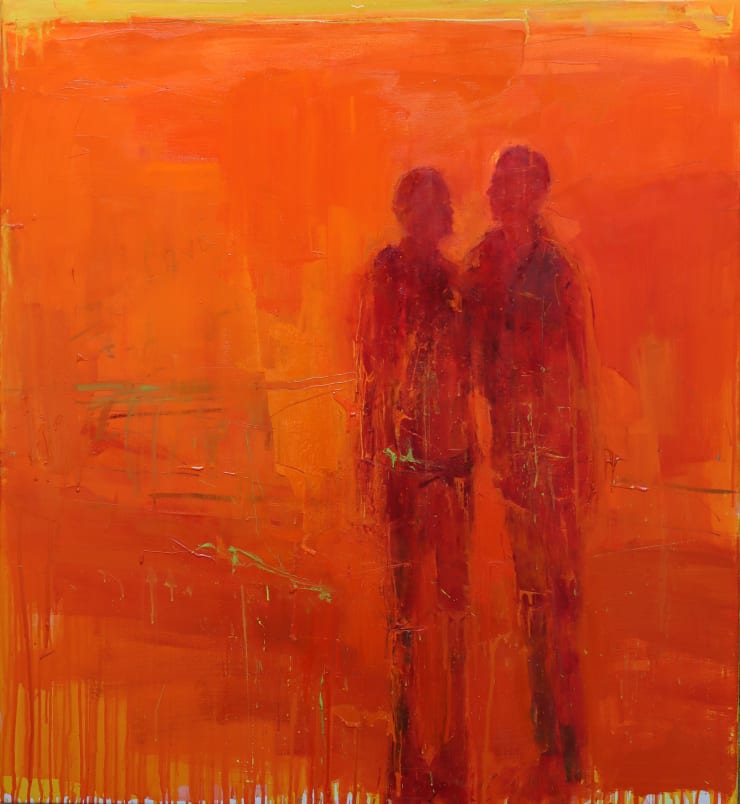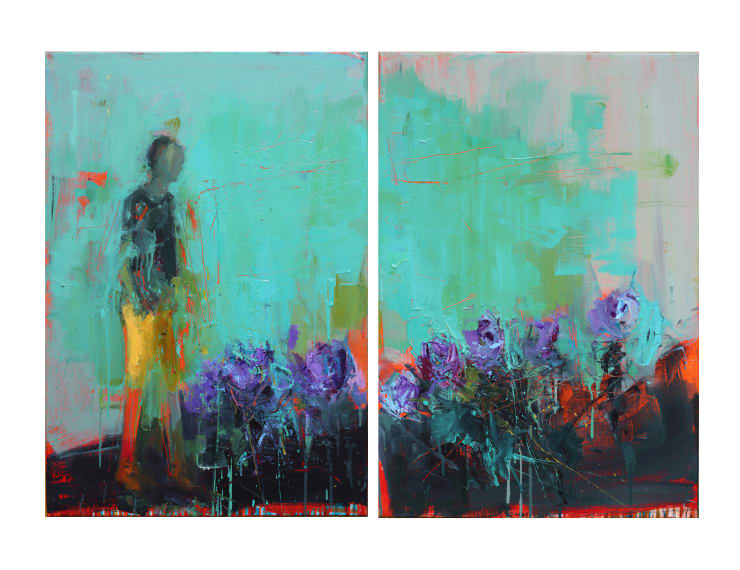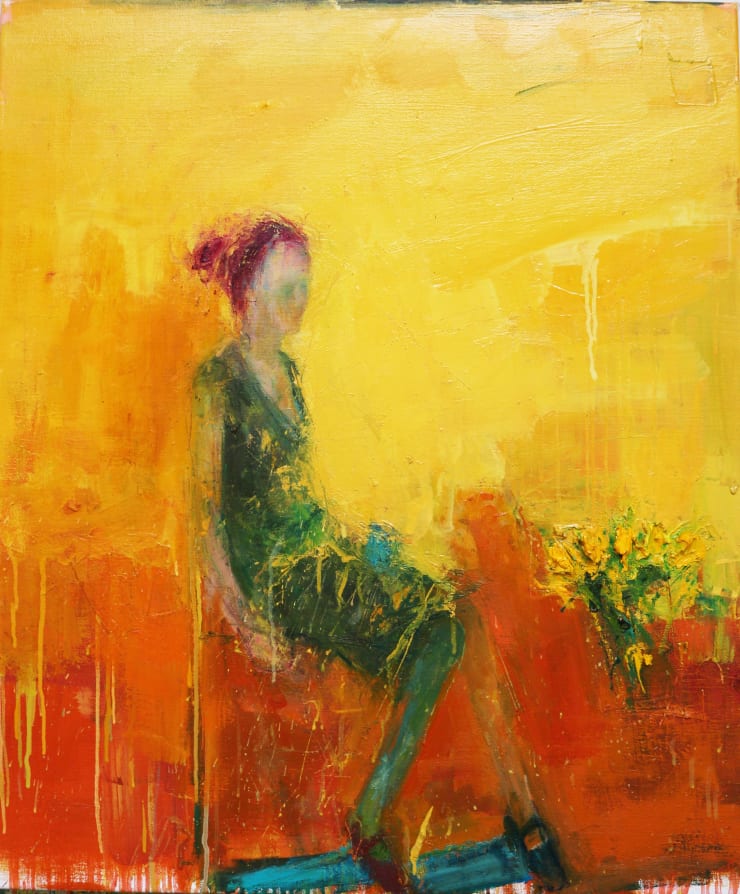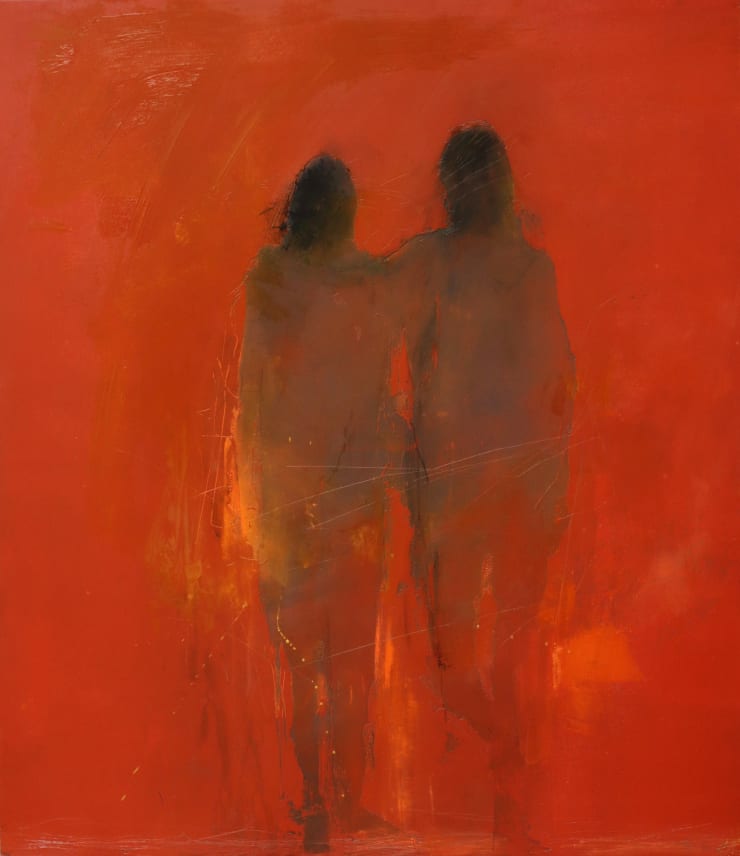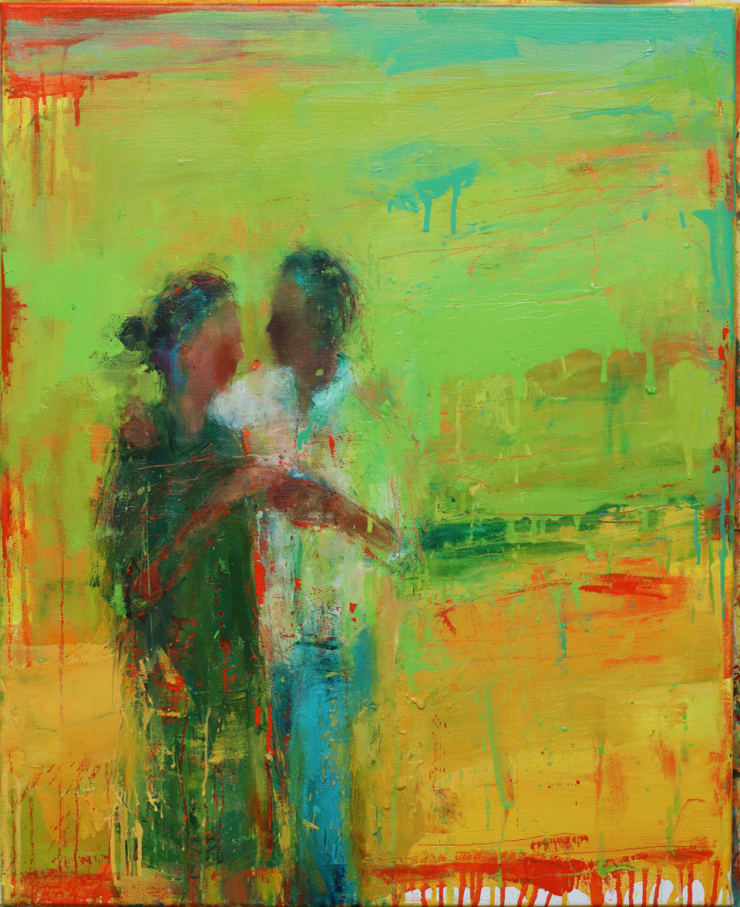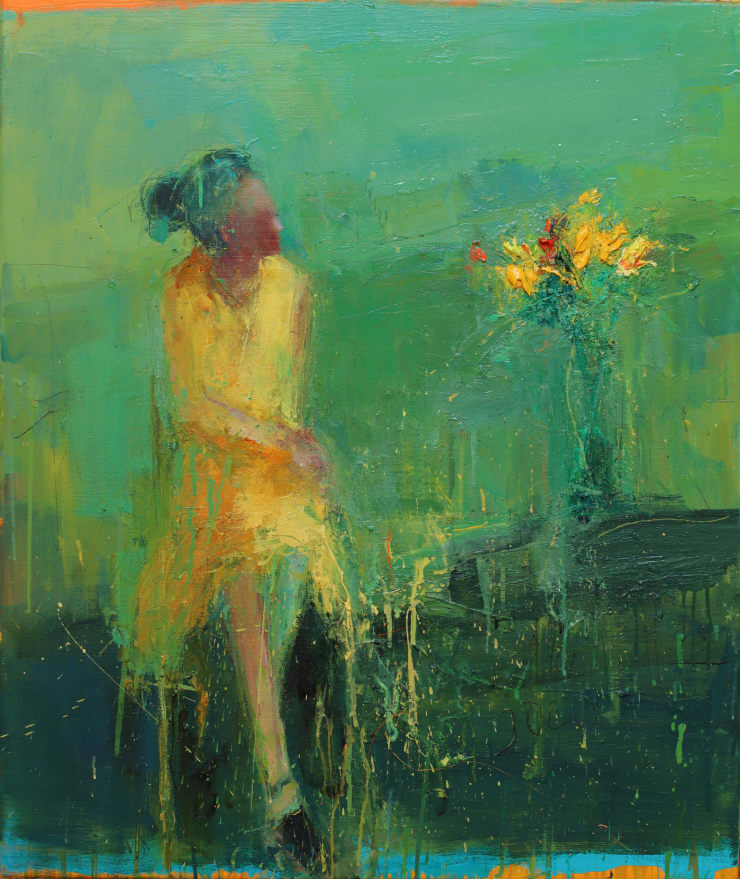Henry Jabbour: Traces Remain
International artist Henry Jabbour was born in Beirut and educated at the New York Academy of Art. He graduated in 2015 with a master's degree in fine art and printmaking. Relatively new to the art world, his paintings display a vivid use of colour and exuberant execution. He paints the figure. His loosely-indicated, schematic images are integrated into a highly worked and abstracted paint surface, scattered with incidental markings and subtle gestures.
Jabbour uses strong colour, high in register and saturation, deploying it for expressive effect rather than descriptive purpose. His is a Mediterranean palette, almost 'Fauvist' in its intensity, characterised by shades, tints and tones of cerulean blue, lemon yellow, scarlet red, tangerine orange and viridian green.
The medium is brushed, smeared and dripped onto the canvas. Applied both thick and thin, the paint film is drawn on and dragged into, and, in places, is layered with impasto. The texture of the paint ranges from watery fluidity to a creamy consistency to a waxy stickiness. This lively and receptive surface registers the imprint of the painter's activity as he conjures up his fugitive images.
The ambiguous human characters are hard to know and grasp the meaning of. They are rendered in a generalised form, deliberately undifferentiated. Theirs is a fleeting presence, a temporary footprint. Going about their mysterious business: walking, carrying or contemplating, they are universal, idiomatic of the everyday, vehicles for the artist's painterly manipulations.
These elusive and sketchily-realised figures are glimpsed as if through a haze of sunlight. We shade our eyes to examine them. They live in a world of paint which both realises and obscures. There is something forensic and archaeological about these sumptuous, fragmentary paintings. The artist has made a site from which he retrieves and uncovers. Traces remain of his excavations.
For SALES & PRESS enquiries
Please email us here or get in touch on WhatsApp.
-
 And Side By Side, 2020Oil on linen120.5 x 110 cm
And Side By Side, 2020Oil on linen120.5 x 110 cm
47.5 x 43.3 in -
 By Silence And By Fragrance, 2020Oil on linen106 x 91 cm
By Silence And By Fragrance, 2020Oil on linen106 x 91 cm
41.7 x 35.8 in -
 By Silence And By Fragrance II, 2020Oil on linen106 x 91 cm
By Silence And By Fragrance II, 2020Oil on linen106 x 91 cm
41.7 x 35.8 in -
 Con La Luz, 2020Oil on linen110 x 95 cm
Con La Luz, 2020Oil on linen110 x 95 cm
43.3 x 37.4 in -
 From My Eyes Into The Day, 2020Oil on linen30.5 x 30.5 cm
From My Eyes Into The Day, 2020Oil on linen30.5 x 30.5 cm
12 x 12 in -
 From The Earth Into Memory, 2020Oil on linen - Diptych30.5 x 61 cm
From The Earth Into Memory, 2020Oil on linen - Diptych30.5 x 61 cm
12 x 24 in -
 In A Timeless Sweet Land, 2020Oil on linen110.5 x 91 cm
In A Timeless Sweet Land, 2020Oil on linen110.5 x 91 cm
43.5 x 35.8 in -
 It Feels Like Hope, 2020Oil on linen - Diptych80.5 x 130 cm
It Feels Like Hope, 2020Oil on linen - Diptych80.5 x 130 cm
31.7 x 51.2 in -
 One In Soul, 2020Oil on linen50.5 x 46 cm
One In Soul, 2020Oil on linen50.5 x 46 cm
19.9 x 18.1 in -
 To Life In Your Hands, 2020Oil on Linen95.5 x 80.5 cm
To Life In Your Hands, 2020Oil on Linen95.5 x 80.5 cm
37.6 x 31.7 in -
 A Scent To Steal Your Heart II, 2020Oil on linen60 x 55 cm
A Scent To Steal Your Heart II, 2020Oil on linen60 x 55 cm
23.6 x 21.7 in -
 When The Light Returns II, 2019Oil on linen96 x 80 cm
When The Light Returns II, 2019Oil on linen96 x 80 cm
37.8 x 31.5 in -
 Where I Used To Be Young, 2020Oil on linen81 x 65 cm
Where I Used To Be Young, 2020Oil on linen81 x 65 cm
31.9 x 25.6 in -
 Toe To Heal, 2019Oil on linen60 x 55 cm
Toe To Heal, 2019Oil on linen60 x 55 cm
23.6 x 21.7 in -
 Love Is Where It Falls II, 2020Oil on linen80 x 76 cm
Love Is Where It Falls II, 2020Oil on linen80 x 76 cm
31.5 x 29.9 in -
 All That I Owe You, 2020Oil and Etching Ink on Copper56 x 49 cm
All That I Owe You, 2020Oil and Etching Ink on Copper56 x 49 cm
22.1 x 19.3 in -
 And I Shall Forever, 2020Oil and Etching Ink on Copper56 x 49 cm
And I Shall Forever, 2020Oil and Etching Ink on Copper56 x 49 cm
22.1 x 19.3 in -
 Daylight Breaks, 2020Oil on linen50.5 x 46 cm
Daylight Breaks, 2020Oil on linen50.5 x 46 cm
19.9 x 18.1 in -
 We're Both Of Us II, 2020Oil on Linen80.5 x 65.5 cm
We're Both Of Us II, 2020Oil on Linen80.5 x 65.5 cm
31.7 x 25.8 in -
 Till Tangled In Ashes II, 2020Oil on Linen95.5 x 80.5 cm
Till Tangled In Ashes II, 2020Oil on Linen95.5 x 80.5 cm
37.6 x 31.7 in -
 The Roots I Left Behind, 2020Oil on linen120.5 x 110 cm
The Roots I Left Behind, 2020Oil on linen120.5 x 110 cm
47.5 x 43.3 in -
 My Infinite Dreams Live, 2020Oil on Linen60.5 x 55 cm
My Infinite Dreams Live, 2020Oil on Linen60.5 x 55 cm
23.8 x 21.7 in -
 Only The Heart, 2020Oil on Linen110 x 95 cm
Only The Heart, 2020Oil on Linen110 x 95 cm
43.3 x 37.4 in -
 We're Both Of Us, 2020Oil on linen95 x 110 cm
We're Both Of Us, 2020Oil on linen95 x 110 cm
37.4 x 43.3 in -
 The Heart Within Me, 2020Oil on Linen30.5 x 30.5 cm
The Heart Within Me, 2020Oil on Linen30.5 x 30.5 cm
12 x 12 in -
 Quietly The Morning II, 2020Oil on linen60 x 55.5 cm
Quietly The Morning II, 2020Oil on linen60 x 55.5 cm
23.6 x 21.9 in -
 Springtime My Heart, 2020Oil on linen95.5 x 81 cm
Springtime My Heart, 2020Oil on linen95.5 x 81 cm
37.6 x 31.9 in

